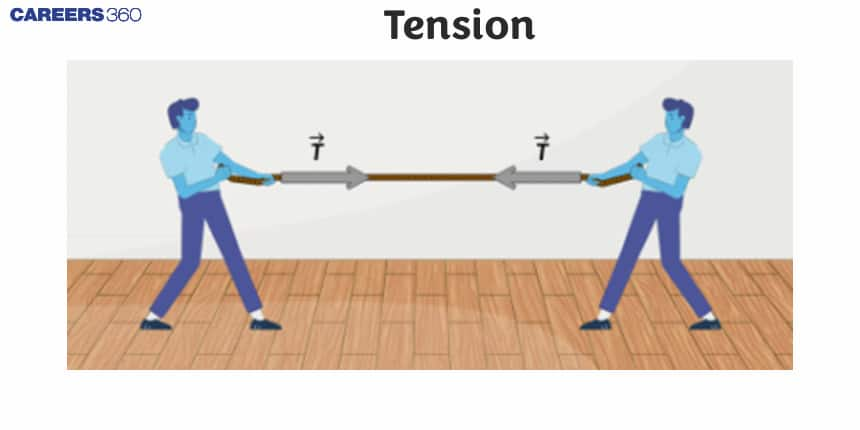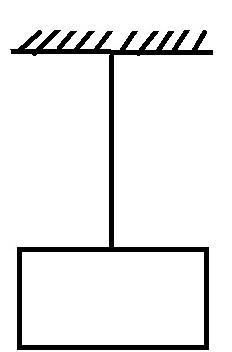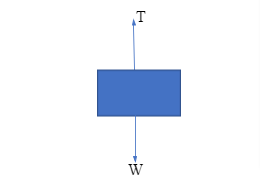Tension - Definition, Examples, Units, Formula, FAQs
What is Tension Force? Tension in physics is a contact force. The tightness of a rope or string when you try to stretch it is called tension.
Tension definition in physics
When two or more physical objects come into touch with each other, they exert forces on each other. These contact forces are given different names depending on the objects in touch. The force is called tension if one of the items in contact is a string, rope, cable, or spring.

Tension Physics -Examples
A stone is suspended with the help of a thread and its free end is fastened to the ceiling, as shown in Figure
Gravity pushes a stone attached to a string down all the time, but the stone does not fall since it is held by the string. As a result, there is a force that pulls the stone upward to support it against gravity.

(Image drawn using Microsoft paint)
The upward tension force balances the gravitational force in the case above, as seen in the diagram below.

(Image drawn using Microsoft word)
Also read -
- NCERT Solutions for Class 11 Physics
- NCERT Solutions for Class 12 Physics
- NCERT Solutions for All Subjects
Tension definition
When forces working from opposite ends pull a cable, rope, wire, or string tight, the tension force is conveyed through the cable, rope, wire, or string. It travels the length of the cable, pulling evenly on the items at both ends.
The action-reaction pair of forces acting at each end of the aforementioned elements can alternatively be defined as tension. Tension can be thought of as the polar opposite of compression.
Cables and ropes can be utilised to exert force because they can efficiently transfer force over a short distance. Because the ropes cannot effectively push, tension is the pulling force.
Tension meaning
In physics, a tension force is the force created when a rope, string, or cable is stretched under a force. Tension is applied along the length of the rope/cable in the opposite direction of the force applied.
Tension meaning in English
The state of being stretched tight.
Tension- units
For suspended objects in equilibrium, the tension is equal to the mass of the object times its gravitational acceleration.
Tension SI units are N (newtons), or kg-m/s²
Tension formula
The tension in the cable/string, which pulling up object, is equal to weight force, i.e. mg, where m is a mass as well as g is acceleration induced by gravity, which is dragging down the object, the system has a constant velocity and is in equilibrium
T=mg (mass multiplied by gravitation)
T is for tension, m is for mass, kg is for gravitational force, and g is for gravitational force.
| Related Topics Link, |
Direction of tension force
This "pull" is a force we refer to as tension. As a result, tension will point away from the mass and toward the string. The string, in the instance of the hanging mass, pulls it up, exerting an upward force on mass, along with tension upwards..
Newton's Laws and Tension Force:
The tension is the final application of Newton's law. Tension normally arises when a force is transmitted through cables or rope. Consider a block that is being dragged by a rope. The person pulling on one end of the rope isn't in contact with the block at the other end, so he or she can't exert direct force on it. As a result, the force is applied to the rope, which then transmits it to the block. The tension force is the force that the block feels as it pulls on the rope.
Classical mechanics is concerned with massless ropes and cables. If a cable or rope has no mass, it transmits force perfectly from one end to the other. For example, if a man pulls the massless rope with 30 N of power, the block will only be subjected to 30 N of force.
The overall force on the rope must be zero at all times, which is a key characteristic of the massless rope. Newton's second law can be used to demonstrate this. If a net force is applied to a massless rope, the result is infinite acceleration A=F/m and the rope's mass is zero.
Because the situation described above is physically impossible, the massless rope will never experience net force.
Also Read:
- NCERT solutions for Class 11 Physics Chapter 5 Laws of Motion
- NCERT Exemplar Class 11 Physics Solutions Chapter 5 Laws of Motion
- NCERT notes Class 11 Physics Chapter 5 Laws of Motion
Why is the Tension of a Massless String Constant?
Because a string is extended and non-rigid, tension exists throughout the thread rather than being applied at a single location, the concept of tension in a string might be difficult to grasp.
What is the Importance of Tension Force?
All physical things that come into contact with one another can exert forces on one another. It's vital to remember that tension is a pulling force because ropes can't effectively push. When you try to pull anything with a rope, it becomes slack and loses the tension that allowed it to pull in the first place.
Also check-
- NCERT Exemplar Class 11th Physics Solutions
- NCERT Exemplar Class 12th Physics Solutions
- NCERT Exemplar Solutions for All Subjects
NCERT Physics Notes:
Frequently Asked Questions (FAQs)
The pull, which is called tension, is the direction of tension. A thread pulls the mass upwards in the case of a hanging mass, hence the string/rope exerts an upper force on the mass and the tension is on the upper side.
The string has a tensile force of 10 N.
The gravitational force acts in the opposite direction of tension. If an object is suspended, tension must be used to keep it balanced; otherwise, gravity will cause it to fall.
Because the rope works as a force transfer agent, there should never be a situation when two items connected by one rope are subjected to tension forces of different magnitudes.
The amount of work done is determined by both force and displacement. Although tension is a force, it does not result in any displacement. In the case of tension, W = F 0 = 0 if the work done is given by the equation W = FS where F is the force and S is the displacement. As a result, tension produces little work.
Questions related to
On Question asked by student community
If you made a mistake in your NIOS class 12 exam OMR sheets such as marking the wrong set code you should not worry because examiners are trained to handle such issues during evaluation. Your roll ,Subject code and other details help them match your paper correctly so one small
Hello Paramesha,
The deadline extension for NEET UG is in complete discretion of competitive authority i.e. National Testing Agency. If you have valid genuine reason you may raise. You may raise your concern on below NTA website by contacting on number or dropping them a email.
https://www.nta.ac.in/contactus
Hope this will
Correct Answer: All of the above
Solution : The correct option is All of the above.
The phrase "Cold War" refers to the geopolitical tension and competition that prevailed in the wake of World War II, particularly between the United States and its Western allies (commonly referred to as the
Correct Answer: surface tension of oils is much smaller than that of water.
Solution : The correct option is surface tension of oil is less than that of water.
The surface tension of water causes oil droplets to disperse over it. Water has a higher surface tension than oil,
Correct Answer: At room temperature, the surface tension of water is less than ethyl alcohol.
Solution : The correct option is At room temperature the surface tension of water is less than ethyl alcohol.
Water has a greater surface tension than ethyl alcohol at a normal temperature. At room